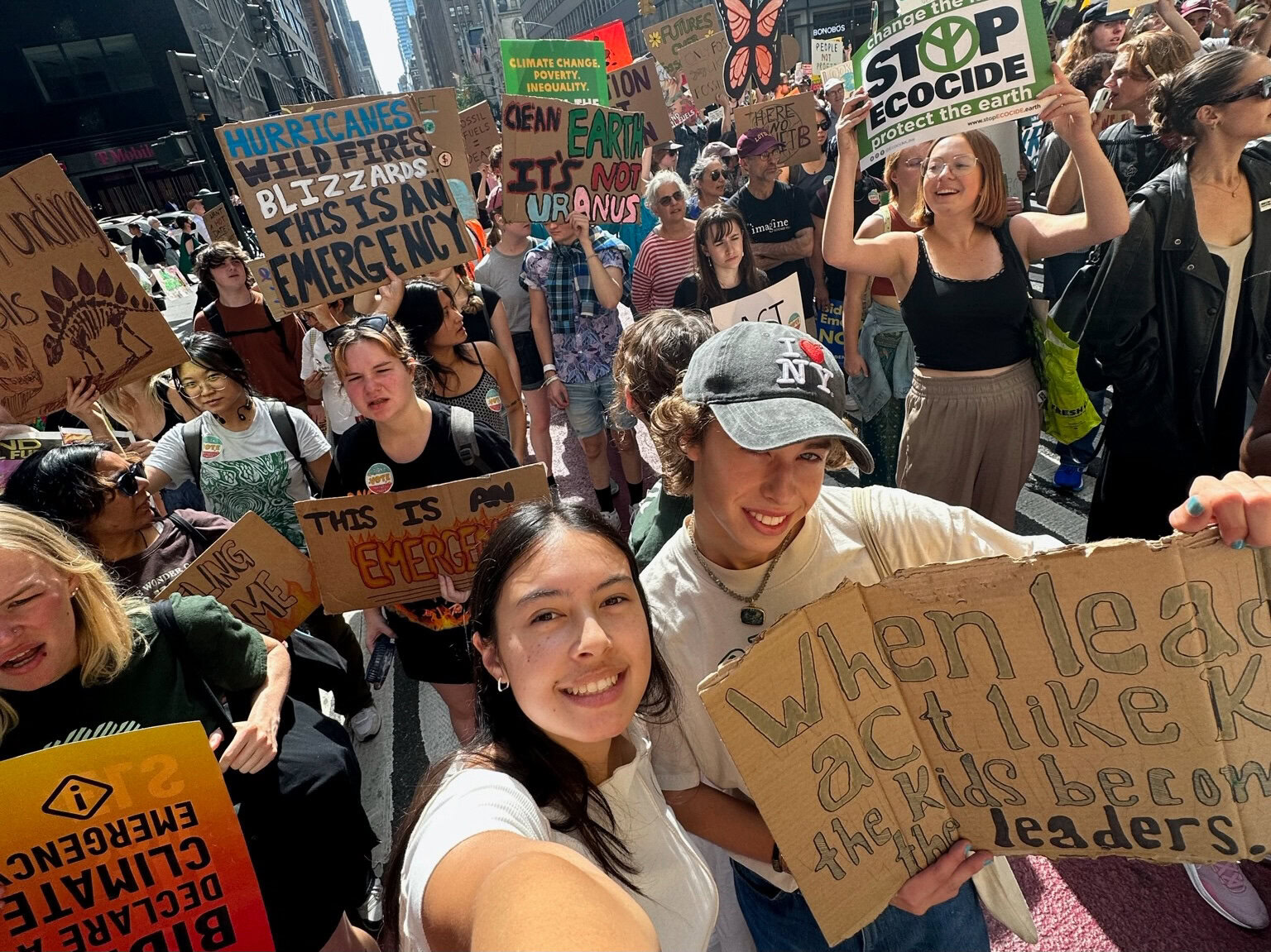Health care
‘Composting Our Emotions’: How Climate Action Cultivates Well-Being
Marinel Ubaldo freezes when she hears heavy rain or intense wind.
“My brain just cannot function,” says Ubaldo, a climate activist who is studying for her master’s degree in environmental management at Duke University in North Carolina. “It triggers my trauma, and all the memories from the past just come rushing to me.”
A decade ago, when Ubaldo was in her last year of high school, her village in the Philippines was hit by Super Typhoon Haiyan. The community on the Pacific-facing shore had experienced many typhoons. Through Ubaldo’s childhood, prepping her family’s oceanfront home for storms was a regular part of life. As Haiyan approached, Ubaldo expected the same storm routine. But this typhoon with winds that reached 195 mph was equivalent to a Category 5 hurricane — much stronger than the storms the community was used to.
 Maribel Ubaldo, a climate activist pursuing a master’s degree in environmental management at Duke University in North Carolina. Credit: Marinel Ubaldo
Maribel Ubaldo, a climate activist pursuing a master’s degree in environmental management at Duke University in North Carolina. Credit: Marinel Ubaldo
From an evacuation center in the building where she’d attended day care, she watched the storm devastate the town. The gymnasium roof floated in the wind like paper, she recalls. A wave washed a baby from the mother’s arms. Her family’s home was destroyed. And in the days after, before outside aid reached them, she and other members of her community just tried to survive.
For Ubaldo, the storm didn’t just leave her with traumatic memories. It also deepened her anxiety about the impacts of climate change, a feeling she says is common among her peers. “It’s overwhelming that you don’t know if you have a future,” Ubaldo says. “You don’t know if your family will still be there next month … because our future is so unpredictable because of climate change.”
As the Earth’s climate alters, regions around the world are facing more intense storms, wildfires, floods, extreme heat, and other phenomena. Less visibly, the multilayered effects of the climate crisis have huge implications for mental health. In a number of surveys, people say climate change causes them stress, worry, or fear. And many, like Ubaldo, are already dealing with anxious feelings and trauma from its impacts today.
Decades of research on the effects of the changing climate have most often focused on the environment. But in 2022, for the first time, an assessment report published by the United Nations’ climate change science arm highlighted the impact of environmental changes on mental health and well-being.
These impacts come with a significant price. Researchers estimate that mental health effects related to climate change will have a total societal cost of $23 billion in 2030, and rise to $245 billion by 2050. “Fundamentally we need to make sure the costs of climate change on mental health are accounted for, and the benefits of climate action to mental health are accounted for and responded to,” says Emma Lawrance, who leads the Climate Cares Centre at the Institute of Global Health Innovation at Imperial College London.
Climate change affects mental health in a range of ways, according to Lawrance, who is helping to lead a global research project, Connecting Climate Minds, that has involved more than 500 people across some 80 countries. Natural disasters can directly affect people’s well-being, as can longer-term shifts like rising sea levels, changing weather patterns, coastal erosion and salinization. These phenomena can lead to loss of livelihoods, migration from home communities, food and water insecurity, and the deaths of loved ones, Lawrance explains. “Understandably, that can be a trauma and an ongoing stress that can lead to, sadly, more cases of anxiety, depression, post-traumatic stress disorder, substance misuse and even death by suicide,” she says.
 Finn Does (front right) and others at the March to End Fossil Fuels in New York in September 2023. Credit: Finn Does
Finn Does (front right) and others at the March to End Fossil Fuels in New York in September 2023. Credit: Finn Does
Research is finding links between these climate-related changes and people’s mental well-being, particularly with extreme heat. A study found that for every one degree Celsius rise in monthly average temperature, suicide rates increased by 0.7 percent in U.S. counties and 2.1 percent in Mexican municipalities. The researchers estimate that by 2050, rising temperatures could lead to between 9,000 and 40,000 additional suicides in the two countries. High temperatures also may raise risks for people who already have mental health challenges. During a 2021 heat wave in British Columbia, eight percent of people who died had been diagnosed with schizophrenia, while only one percent of the province’s general population has the condition.
There are physical effects of climate change, too, which in turn can have implications for mental well-being. During his career in cardiology, Bob Dewey saw more patients with chronic lung disease come into his office in New Hampshire in warm months when pollen counts were high. Over recent decades, climate change has resulted in longer pollen allergy seasons. These underlying health conditions are connected to mental well-being, says Dewey. “When you have trouble breathing it’s very easy to panic,” he says. “It’s just an extremely scary thing to know that you’re vulnerable to this kind of situation.”
Crushed by negative news?
Sign up for the Reasons to be Cheerful newsletter.
[contact-form-7]
In general, environmental changes are compounding issues faced by people who are more vulnerable. “Climate change is essentially a risk multiplier,” Lawrance says.
Meanwhile, stress and anxiety about the climate — often called eco-anxiety or climate distress — are taking a toll on some. In a study that surveyed 10,000 young people in 10 countries, 45 percent said that feelings about climate change “negatively affected their daily life and functioning.” According to Google, English-language searches related to “climate anxiety” were 27 times higher in the first 10 months of 2023 compared with the same period six years earlier.
Distress about the environment and climate is not necessarily a mental health condition on its own, according to Lawrance. “But it can be an ongoing stressor that without support can worsen people’s mental well-being, disrupt their sleep, disrupt their daily life.”
Finn Does used to feel paralyzed by bad news about the climate crisis. The San Francisco Bay Area 18-year-old says he often read headlines and saw social media posts about environmental disasters and alarming studies. “I was caught in this whirlpool of all this news about climate change and the climate crisis,” he says.
 Finn Does (center), summit co-chair, and other youth participants at the 2023 Bay Area Youth Climate Summit in San Francisco, California. Credit: Finn Does
Finn Does (center), summit co-chair, and other youth participants at the 2023 Bay Area Youth Climate Summit in San Francisco, California. Credit: Finn Does
For Does, anxiety around climate change led to feelings of despair, guilt, grief, hopelessness and fear. Then one day, as wildfires blazed in California, the sky in the Bay Area turned orange. The scene was “apocalyptic,” he recalls. He describes that day as a wake-up call that spurred him to take action. “I was just thinking about, ‘Wow, I have a whole life ahead of me,’” Does says. “If this is happening right now at such a young age, what’s going to be happening to me 10, 20, 30, 40 years from now?”
Now a senior in high school, Does is co-chair of the Bay Area Youth Climate Summit, an environmental justice activism network. He’s also involved in a project researching emotions related to climate change among young people across California. Through his research and conversations with other young people, his impression is that those who aren’t involved in climate work seem to feel more isolated and pessimistic. Meanwhile, people who participate in climate action seem to feel a sense of community and connection. “They have an extreme amount of awareness about climate, which gives them a lot of fear and a lot of anxiety,” Does says. “At the same time, they have way more optimism and way more hope than those folks that aren’t involved in climate work.”
Along those lines, taking part in collective action related to the climate may help relieve eco-anxiety, suggests a study led by the Yale School of Public Health published in 2022. Robert Feder, a retired psychiatrist and member of the Climate Psychiatry Alliance and NH Healthcare Workers for Climate Action, says that for mental health professionals, treating eco-anxiety involves trying to help people strengthen their responses to stress. Alongside general tools for resilience — like eating well, exercising and mindfulness techniques — building up social connections is important, he says. Getting involved with climate work can help people find social supports and address stress linked to climate change. “Not just sitting and worrying about it and feeling distressed about it, but doing something about it is really the most helpful thing to deal with the anxiety that it causes,” says Feder.
Experts say climate action can take many different forms. Some people might enjoy demonstrating in the streets, but others may find environmentally minded groups that suit their particular interests.
 Finn Does (fifth from left) and others at the March to End Fossil Fuels in New York in September 2023. Credit: Finn Does
Finn Does (fifth from left) and others at the March to End Fossil Fuels in New York in September 2023. Credit: Finn Does
When the Rotary Club of Orléans, Ontario, launched a project in 2023 to work with high school students to plant 1,000 trees outside of Ottawa, part of the goal was to create an opportunity for young people to address feelings of eco-anxiety by engaging with the environment, according to Phil McNeely, who chairs the club’s environmental sustainability committee. One rainy day in May 2023, 70 teenagers came out to plant trees on farmland. Based on this initiative, the club is now working with other local Rotary clubs to create the Ottawa Rotary Youth Forest, a reforestation project that will involve students from area schools in planting and caring for trees. “They’ll get an outlet, I think, for their frustrations about climate change,” says McNeely.
There are also groups that convene specifically with the aim of talking about emotions related to the climate crisis. Does, for instance, has led “climate cafes.” These facilitated conversations create an opening for people to discuss their feelings about climate change’s threats to the world, says Wendy Greenspun, a New York City-based psychologist and a member of the Climate Psychology Alliance North America, who leads climate cafe trainings. “People often feel quite isolated. It’s not a topic that we often think of bringing up at a dinner party,” Greenspun says. “So creating a space that’s outside of our usual hustle and bustle and ways of being social in itself already provides something.”
 Members of the Rotary Club of Orléans, Ontario, Canada, initiated a project with high school students to plant 1,000 trees. Credit: Dorothy Berthelet
Members of the Rotary Club of Orléans, Ontario, Canada, initiated a project with high school students to plant 1,000 trees. Credit: Dorothy Berthelet
For some people, group discussions may not be enough support — Greenspun and other psychologists also treat people who benefit from individual therapy. But for many, she says, the group setting provides an avenue to air negative emotions. Through the process people begin to feel validated and less alone. “I call it composting our emotions,” says Greenspun. “New feelings can start to emerge and grow, like a sense of excitement that ‘maybe I can do something,’ a sense of deep meaning and connection with others, a sense of solidarity, a sense of courage.”
Approaches to help people, particularly young people, cope with climate distress are growing around the world. For instance, SustyVibes, an organization based in Nigeria, is creating online and in-person opportunities to discuss eco-anxiety among Africans. The Good Grief Network, based in the US, focuses on building resilience. The UK-based Resilience Project trains leaders of “resilience circles” where peers can support each other. The Climate Cares Centre, which Lawrance leads, launched a guided journal to help young people manage eco-anxiety and transform negative feelings into positive actions.
But climate action doesn’t completely address the mental health burden. Among young activists, there’s a risk of burnout. And while young people are increasingly discussing these climate-related emotions among themselves, there’s also a need for older people to support young people experiencing eco-anxiety, Lawrance says. “We see a big need to equip teachers and parents and train medical professionals and mental health professionals so they’re validating these experiences of distress,” she says.
Meanwhile, many communities are already dealing with the effects of climate change — including on mental health.
In the Philippines, Ubaldo sees the influence it has on her peers, many of whom worry for the safety of themselves and their families and question whether they want to have children because of the changing environment. The Philippines is among the countries most vulnerable to climate change. In a survey of young people in 10 countries, Filipinos reported the highest levels of climate anxiety.
 High schoolers in Orléans, Ontario work on a tree-planting project. Credit: Dorothy Berthelet
High schoolers in Orléans, Ontario work on a tree-planting project. Credit: Dorothy Berthelet
Reducing stigma around mental health and increasing access to services is important to support communities hurt by climate disasters, Ubaldo says. Incorporating mental health into disaster response could help people talk about their feelings and move forward. “We have to ensure that these experiences are processed or addressed before we experience another super typhoon, because it really adds to our capacity if we know that what we are experiencing or what we are feeling is valid,” she says.
Ubaldo is a registered social worker in the Philippines, and as a volunteer, she’s worked with people who have experienced disasters. But she says there’s a need for government support of such relief services and for more capacity to manage the mental health effects of a climate-related disaster. “I know that there is a great need from the conversations that I have with the community members whenever I’m doing a debriefing after a disaster,” Ubaldo says.
Around the world, initiatives are working to build up mental health treatment services in regions that are particularly vulnerable to climate change. Rotary members in southeastern Australia, for example, helped start Trauma Recovery Network Australia to train health care professionals in rural areas so that communities are better positioned to counter possible mental health harms of disasters. “For mental health, you need people there, and continuously,” says Pam Brown, a psychologist and a member of the Rotary Club of Gisborne who led the creation of the network.
The initiative, which began in 2020, holds workshops in regions hit by wildfires. Often areas that are vulnerable to fires are also susceptible to other climate change impacts, like coastal erosion or weather changes that affect farming. In rural areas, mental health professionals may have fewer opportunities for trauma treatment training, and community members don’t have easy access to local support, Brown explains.
After bushfires in 2019 and 2020, the Australian network began training groups of social workers, psychologists, counselors, and other mental health experts on how to treat people using a technique called eye movement desensitization and reprocessing. In the treatment, people bring up a traumatic memory while simultaneously engaging in “bilateral stimulation,” something like shifting their eyes from one side to the other or tapping their hands in an alternating pattern. The approach has been endorsed as a treatment for trauma by the World Health Organization, the American Psychological Association, and the Australian Psychological Society, among others. Studies find that the treatment reduces symptoms of PTSD and other distress among survivors of disasters including earthquakes, hurricanes and floods.


Become a sustaining member today!
Join the Reasons to be Cheerful community by supporting our nonprofit publication and giving what you can.
Meanwhile, the mental health reverberations of Australia’s bushfires linger. A survey of people affected by the fires 12 to 18 months later found high levels of distress, including anxiety and depression. Over 60 percent of the nearly 100 mental health professionals who participated in the Trauma Recovery Network Australia trainings have completed the requirements needed to join the national association for practitioners of eye movement desensitization and reprocessing, and even more have used the treatment in their practice, Brown says. “It’s helping therapists not feel so helpless,” she says.
Supporting mental health in the face of climate change is not only about responding. Building psychological resilience can also be incorporated into climate adaptation efforts, Lawrance says. Strengthening social connections and being prepared for climate events can buffer against mental health strains. “We know that when a disaster hits, the communities that have stronger social bonds tend to be the ones who are less affected psychologically and more able to respond practically than those that have weaker social ties,” Lawrance says.
As the connection between mental health and climate comes into the spotlight, one of the challenges is understanding the full extent of this intersection. Data is hard to gather because there are so many ways that climate could intertwine with well-being. But research is growing, as are approaches to supporting mental health against climate change stressors. “There are these vicious cycles of compounding challenges, but it also means that there are compounding opportunities when we take action,” Lawrance says. “There is a brighter future to be working toward that is better for the climate and also better for our minds.”
This story is a collaboration between Rotary magazine and Reasons to be Cheerful.
The post ‘Composting Our Emotions’: How Climate Action Cultivates Well-Being appeared first on Reasons to be Cheerful.
Women’s homelessness
I’ve just published Chapter 8 of my open access textbook. This new chapter focuses on women’s homelessness.
An English summary of the new chapter can be found here: https://nickfalvo.ca/womens-homelessness/
A French summary of the new chapter is here: https://nickfalvo.ca/litinerance-chez-les-femmes/
All material related to the textbook can be found here: https://nickfalvo.ca/book/
Women’s homelessness
I’ve just published Chapter 8 of my open access textbook. This new chapter focuses on women’s homelessness.
An English summary of the new chapter can be found here: https://nickfalvo.ca/womens-homelessness/
A French summary of the new chapter is here: https://nickfalvo.ca/litinerance-chez-les-femmes/
All material related to the textbook can be found here: https://nickfalvo.ca/book/
Universities Are Making Billions Gatekeeping Your Meds
Research universities, many of them public, have joined forces with pharmaceutical companies and Wall Street firms to fight new government efforts to curtail out-of-control drug prices, saying the regulations could stifle innovation.
But these universities are also likely concerned that drug-price reforms would hamper their profits. Case in point: the University of California, Los Angeles (UCLA) has quietly reaped more than a billion dollars in payouts from Xtandi, a lifesaving cancer drug that it developed with the help of government funding and now costs U.S. patients $200,000 a year.
This is not a paywall. You can read the full story for free.
Just sign up below for a free subscription to The Lever to get access to this story and much more.
Already have an account? Sign in
Pfizer’s Massive Tax Dodge
While jacking up drug prices, Pfizer recently reported more than $27 billion in revenue from its U.S. sales in 2023. But the Big Pharma titan owes nothing in federal income taxes, despite being one of the most profitable pharmaceutical companies in the world. That’s largely thanks to existing loopholes and a 2017 tax law signed by former President Donald Trump.
Pfizer is not the only giant corporation raking in huge profits but paying fewer taxes than the typical American household: More than 100 of the country’s most profitable corporations paid zero federal income taxes in at least one year since the Trump tax cuts were enacted.
This is not a paywall. You can read the full story for free.
Just sign up below for a free subscription to The Lever to get access to this story and much more.
Already have an account? Sign in
Where Nursing Homes Hide Their Profits
Last June, an elderly stroke survivor residing at Chicago’s Lakeview Rehab and Nursing Center fell to the floor while being transferred by mechanical lift from his bed to a shower chair. The fall broke his leg in two places. A single nurse’s aide had texted her coworkers three times seeking help before attempting the lift. None responded. The nurse — in a clear violation of a requirement that two aides conduct any high-risk transfer — went ahead on her own.
It wasn’t an isolated incident at the 178-bed facility. Since the beginning of 2021, federal regulators fined Lakeview Rehab, which is run by privately-owned Infinity Healthcare Management, more than $250,000 for 10 serious violations, according to the government’s Nursing Home Compare website. The facility earned just one out of five stars for quality, the lowest possible rating.
This is not a paywall. You can read the full story for free.
Just sign up below for a free subscription to The Lever to get access to this story and much more.
Already have an account? Sign in
The New War Over Generic Drugs
As the price of prescription medications rises, generic drugs offer a way for consumers to save money. Although generics have the same active ingredients as brand-name drugs and result in the same clinical effect, they typically cost up to 85 percent less.
But now, the generic drug industry is pushing back against a government effort to lower the cost of lifesaving medications, even though the plan is built around letting them make more generic drugs. In government filings reviewed by The Lever, generic drugmakers insist the initiative threatens their own monopoly rights — which allow them to inflate their profits and keep even generic drug prices artificially high.
This is not a paywall. You can read the full story for free.
Just sign up below for a free subscription to The Lever to get access to this story and much more.
Already have an account? Sign in
This New Lawsuit Could Rescind Your Health Care Benefits
Earlier this month, a three-judge panel of the New Orleans-based U.S. Court of Appeals for the Fifth Circuit signaled it will affirm a lower-court ruling striking down the Affordable Care Act (ACA)’s requirement that private insurance plans cover preventive services at no cost to patients. Once the Fifth Circuit issues its expected ruling, the Supreme Court will get another chance to strike a grievous blow to the public’s health.
In September 2022, Judge Reed O’Connor of the U.S. District Court in the Northern District of Texas (the court where many anti-ACA rulings originate) declared that the executive branch could not use the U.S. Preventive Services Task Force to determine which services would be covered by the mandate. The 2010 ACA said all services given an “A” or “B” rating by the task force must be covered without copays or deductibles. After the ruling, the government appealed to the Fifth Circuit.
This is not a paywall. You can read the full story for free.
Just sign up below for a free subscription to The Lever to get access to this story and much more.
Already have an account? Sign in
What If Finding Affordable Housing Worked More Like Matchmaking?
Dozens of framed photographs and paintings on the walls in Gabrielle’s cozy one-bedroom apartment in Boyle Heights showcase her artistry and cherished memories from trips to New Zealand and Europe. Her favorite is a black and white portrait of a miner in New Zealand panning for gold.
Gabrielle (who is comfortable printing only her first name) feels she struck gold, too, when she moved into this light-filled apartment in September 2019. She calls the place — with an open kitchen, a large bathroom and a sweeping view over park greenery and palm trees to the snow-capped mountains outside of Los Angeles — her “safe haven,” after feeling unsafe for several years.
A professional gemologist whose family once had five jewelry stores in Hawaii, she had struggled with alcoholism and mental health issues, and a suicide attempt left her in a coma for five days. While she was recovering from major neck surgery and fighting to be granted disability, she was living in her car in Los Angeles for several months and in transitional housing for more than 15 months. She wondered if she would ever have an apartment again or “be stuck in a hell hole forever.”
 A 2020 report found that Los Angeles had more than one vacant residential unit for every unhoused person. Credit: Ocean Image Photography / Shutterstock
A 2020 report found that Los Angeles had more than one vacant residential unit for every unhoused person. Credit: Ocean Image Photography / Shutterstock
Gabrielle’s luck began to change when a California nonprofit called Brilliant Corners got involved. She had qualified for help from the Los Angeles County Department of Health Services Housing for Health division that gives priority to vulnerable clients with health issues. (Gabrielle contributes 30 percent of her income to the rent, and the rest is covered by the program’s subsidy.) But when the Boyle Heights apartment in a former hospital opened up, the landlord didn’t want to rent to her because of her bad credit. The real estate specialists at Brilliant Corners worked with Gabrielle’s case manager at the local nonprofit Life Steps to convince the landlord he was not taking a big risk in accepting Gabrielle as a renter.
Brilliant Corners was founded in 2004 by several nonprofit service providers with the mission to find housing for people with intellectual and developmental disabilities in three California counties. In 2014, it significantly expanded its mission to extremely low-income Californians and began operating the Flexible Housing Subsidy Pool, in partnership with the Los Angeles County Department of Health Services and private partners such as the Conrad N. Hilton Foundation, as part of the Housing for Health initiative. The Flex Pool is a supportive housing rent subsidy program that helps match vulnerable individuals with available housing options.
Crushed by negative news?
Sign up for the Reasons to be Cheerful newsletter.
[contact-form-7]
The key is its flexibility: “For one landlord, it was a dealbreaker that the applicant had $3,000 in debt. So we paid off half the debt,” says Kolby Vaughn, Brilliant Corners’ associate housing services director in San Diego, which has a Flex Pool that is funded by the Regional Task Force on Homelessness. “For another client, cooking was really important so we spoke with the landlord [to see] if we could put a hot plate in his unit. These are the kind of hurdles we can overcome outside of the bureaucratic process.”
With a budget of over $200 million, braiding state, local and private funding sources, Brilliant Corners has been able to make a significant impact. “We have developed the capacity to administer over $10 million of rent subsidies every month,” according to Brilliant Corners CEO Bill Pickel. To date, the nonprofit has placed nearly 13,000 unhoused people into permanent homes in Los Angeles, averaging about 200 people a month. Brilliant Corners contracts with government agencies, such as the L.A. County Department of Health Services or Veterans Affairs, other nonprofits and community partners, and pairs up with Intensive Case Management Services to help clients achieve and maintain health and housing stability.
Its initial efforts in L.A. focused on the most vulnerable clients who frequently used costly emergency services. This is how Brilliant Corners makes the case that it actually saves the county money. According to a 2017 Rand study that analyzed the first two and a half years of the program, every $1 invested in the program saved the county $1.20 in health care and other social service costs. The idea is that once clients have stable housing, they have a better foundation to address other issues including their physical and mental health.
 Brilliant Corners housing coordinator Adriana Flores helped Brian Wearren get over housing hurdles. Credit: Morgan Soloski
Brilliant Corners housing coordinator Adriana Flores helped Brian Wearren get over housing hurdles. Credit: Morgan Soloski
“Clients are typically referred by a government agency or a local case management nonprofit,” Pickel explains, as was the case with Life Steps, the local nonprofit that helped Gabrielle. “We meet individuals one on one.” BC’s housing coordinators provide support from the initial contact all the way through. “They are sticking with one person and don’t leave them alone once they are in an apartment,” says Pickel. “Most folks need some level of ongoing support.”
NPR calls Brilliant Corners a “real estate agency for the unhoused,” because what distinguishes it from other housing programs is its dedicated team of landlord engagement specialists who build long-standing relationships with landlords so they know when a unit will become available. This strategy is considerably different from the normal bureaucratic process where overworked case managers need to find the time to canvas neighborhoods and rental portals for available apartments.
“Especially in California communities where the real estate market is so intense and vacancies are so limited, landlords have lots of choices and might go with someone who just landed a job at Google or Facebook,” Pickel notes. “How can low-income folks possibly compete in such a competitive market to secure a unit? We help put everything in place to match somebody with the unit.” Brilliant Corners sometimes enters into long-term agreements with landlords; these could include guaranteeing rent from day one even before the tenant moves in and assurances that rent is paid on time.
Manola Rodriguez, for instance, who owns and manages 50 apartment units in Antelope Valley with her husband, met Brilliant Corners representatives when they were canvassing the neighborhood in 2014. She has been renting half of her units to Brilliant Corners clients ever since. “We believe in second chances,” she says. “It’s very hard for people to function without a roof over their head.”
Despite its convincing model, Brilliant Corners has dozens of one-star reviews on online platforms where both clients and landlords complain that they have been unable to reach anybody at the nonprofit when problems arose, such as a rodent infestation or behavioral issues with mentally ill renters. But Rodriguez says that Brilliant Corners representatives were always there to assist with problems.
 Brilliant Corners client Brian Wearren enjoys his apartment building’s rooftop. Courtesy of Brilliant Corners
Brilliant Corners client Brian Wearren enjoys his apartment building’s rooftop. Courtesy of Brilliant Corners
To cut through even more red tape and avoid cumbersome bureaucracy, Brilliant Corners is currently developing five multifamily housing sites in L.A., totaling 376 units of permanent supportive housing. The nonprofit is also managing its own residential care homes.
The situation is particularly dire in Los Angeles County, which counted more than 75,500 unhoused people in 2023, an uptick of nine percent from 2022. The homeless number in the city has gone up 10 percent to 46,260, and more than 2,000 unhoused people died last year in the city amidst the housing and fentanyl crises, more than six deaths a day. The alarming death rate, too, rises significantly every year.
A Harvard study shows that low-rent units under $1,400 a month have disappeared fast across all states, particularly in California. “We’re rehousing people faster and more people. Even though the number of people we are able to house is rising, the number of people who need affordable housing is rising faster,” Pickel admits. “What comes to mind is the unfortunate image of bailing water out of a boat, but there’s more water coming in than we can bail out.”
On her first day in office in December 2022, L.A. Mayor Karen Bass signed an emergency declaration on homelessness, promising to cut red tape and fast-track affordable housing permits. Activists laud her efforts, but they are far from enough. “Billions are being spent. What are we doing wrong?” Pickel asks. “I think we have a multi-generational complex social problem that includes the failure to build enough housing at various income levels, including middle-income housing, workforce housing and deeply affordable housing. We also have a tragically fractured social safety net and an unfolding crisis of people in severe distress, whether it’s from mental health, substance abuse or so many other reasons. It is really hard to develop our way out of this problem. We would need something in the order of $10 to $12 billion a year. That’s a staggering number.”
Similarly, in San Diego, Kolby Vaughn says that more people end up unhoused for the first time than Brilliant Corners and other services can put in apartments. Many seniors are aging into homelessness because their pensions are not keeping up with housing prices. Since launching the San Diego Flex Pool in October 2020, Brilliant Corners has housed 900 individuals and families in need, with a focus on youth, veterans and those with complex health issues. But the need continues to mount: California needs 1.4 million more affordable rental units.
At the same time, studies also show that a significant percentage of high-rent housing is lying vacant, held for its value not as shelter, but for investment purposes. A 2020 report found that Los Angeles had more than one vacant residential unit for every unhoused person.


Become a sustaining member today!
Join the Reasons to be Cheerful community by supporting our nonprofit publication and giving what you can.
This is where Brilliant Corners sees a lever to offer landlords incentives to rent to their clients by giving them assurances other nonprofits can’t. “We’re not building our way out of homelessness,” Brilliant Corners housing coordinator Adriana Flores says. She has experienced housing insecurity herself. “A lot of us have been in our clients’ shoes,” she says, and she calls what she offers them “a hand up, not a handout.”
Her client Brian Wearren is a success story. After being honorably discharged from the Navy and then having been incarcerated for 25 years for assault and robbery, Wearren faced some hurdles to finding housing: He had no rental history, no credit and no income. But he found himself a one-bedroom apartment in San Diego on the 12th floor with a view over the city. Brilliant Corners helped him pay for application fees and furniture, and Flores assured the landlord the rent was guaranteed with his VA (Veterans Affairs) rent voucher. Now he works two jobs as a plumber and a fiber optics cable installer and wants to pay it forward.
“I’m extremely lucky and had a lot of support, but not everybody is so lucky,” Wearren says. “I want to establish transitional housing for guys like me who come out of the military or out of incarceration.”
The post What If Finding Affordable Housing Worked More Like Matchmaking? appeared first on Reasons to be Cheerful.
How Covid Changed Nursing
Three New York areas nurses reflect on the outbreak and aftermath of Covid-19.